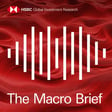Become a Creator today!Start creating today - Share your story with the world!
Start for free
00:00:00
00:00:01

DigiTalks - Future of Insurance: Adapting to Digital
Managing data is paramount for today’s insurers. Here we focus on how insurers can better manage their data by looking at how data can be used and stored more effectively.
Listen as Sam Ray, Director in the Insurance Sector Product team, Markets & Securities Services HSBC discusses this in detail with Paul Clark, Head of Digital, Data & Innovation - Europe & Americas.
Hosted on Acast. See acast.com/privacy for more information.
Transcript
Introduction to HSBC Global Viewpoint & Digitalks
00:00:01
Speaker
Welcome to HSBC Global Viewpoint, the podcast series that brings together business leaders and industry experts to explore the latest global insights, trends, and opportunities.
00:00:12
Speaker
Make sure you're subscribed to stay up to date with new episodes.
00:00:15
Speaker
Thanks for listening.
00:00:16
Speaker
And now onto today's show.
00:00:22
Speaker
Welcome to the latest in our Digitalks podcast series.
00:00:27
Speaker
We will be featuring a variety of different topics and market developments that are currently trending globally.
00:00:33
Speaker
Managing data is paramount for today's insurers.
00:00:37
Speaker
We will focus on how insurers can better manage their data by looking at how data can be used and stored more effectively.
Data Management Architectures for Insurers
00:00:44
Speaker
Joining me to discuss this further is Sam Ray, Director in the Insurance Product Team at HSBC's Markets and Security Services, and Paul Clark, Head of Digital Data and Innovation, Europe and the Americas.
00:00:57
Speaker
Sam, over to you.
00:01:00
Speaker
Thanks, Gabriella.
00:01:02
Speaker
Paul, to kick us off, can you describe some of the different architectures that data can be stored in and why firms would look to use these?
00:01:08
Speaker
Thanks, Sam.
00:01:11
Speaker
Yes, of course.
00:01:11
Speaker
So, look, there's a number of different architectural approaches to storing and managing data.
00:01:18
Speaker
And actually, they all have different pros and cons.
00:01:22
Speaker
At the more traditional end, there are data warehouses where data is defined and categorized or structured up front at the point of load.
00:01:31
Speaker
This means the data in there is easy to query, has a structure to it which is helpful to navigate.
00:01:38
Speaker
It usually has an overall data model which describes how all the data fits together.
00:01:44
Speaker
On the flip side, warehouses are not so good at handling unstructured data like images,
00:01:50
Speaker
Because all the modeling work happens up front, they can be very slow to implement.
00:01:56
Speaker
Typically, you need a central data team to handle the structure of the data, and that causes handoffs and bottlenecks, which can be inefficient.
Analyzing Data Warehouses vs. Data Lakes
00:02:06
Speaker
Then a few years ago, data lakes started to become very popular.
00:02:11
Speaker
Data lakes operate differently to data warehouses in that you don't worry about structuring the data when you load it.
00:02:19
Speaker
Instead, you define the structure at the point you need to extract that data, and you do that on a kind of use case by use case basis.
00:02:28
Speaker
And that means you can make great progress really quickly with loading data, but it can also be very easy to fall into a trap of having poor governance or control over the data that's in there.
00:02:40
Speaker
Suddenly, you're 18 months in, you start to realize you're not sure exactly what data is in there or who owns that data or whether it's up to date.
00:02:49
Speaker
and how it's being used.
00:02:50
Speaker
So when people talk about their data lake becoming a data swamp, this is what they're referring to.
Exploring Data Fabrics and Meshes
00:02:57
Speaker
Then more recently, data fabrics and data meshes have emerged, and they've got a different approach too.
00:03:05
Speaker
So these are designed to democratize the data in a firm by giving producers and consumers of data a set of common tools to load, define, and use that data.
00:03:15
Speaker
In HSBC, in security services business, for example, we've built a data mesh where producers of data can load their data sets in and consumers can use those to build their solutions all without needing a central data team to own those processes.
00:03:33
Speaker
We think this self-service approach with common infrastructure is a good solution for a large distributed business like ours, but
00:03:43
Speaker
As I said at the start, there's no real right or wrong here.
00:03:47
Speaker
Thanks, Paul.
Effective Data Governance and Use
00:03:48
Speaker
Looking beyond the structure that the data is stored in, can you run us through some of the important characteristics that data needs to have in order to be effectively utilized?
00:03:58
Speaker
Sure.
00:03:58
Speaker
Well, it's actually a huge question.
00:04:01
Speaker
We're talking here about metadata or data about data.
00:04:07
Speaker
And it's a whole error in itself.
00:04:09
Speaker
But in the interest of time, I'll pick out just four
00:04:13
Speaker
important areas as an overview.
00:04:15
Speaker
The first is data lineage.
00:04:17
Speaker
This is basically having visibility and an audit trail of where data has come from, who owns it and how it's changed over time.
00:04:27
Speaker
And this is critical, of course, because if you want to use data for anything, you have to know where it came from.
00:04:32
Speaker
You have to know whether the owner of that data will allow you to use it and you have to know whether that data changed and is up to date.
00:04:42
Speaker
The second is data discoverability.
00:04:45
Speaker
We talked before about data lakes becoming data swamps.
00:04:47
Speaker
One of the key causes of that is a lack of data discoverability.
00:04:51
Speaker
What we mean by that is an ability to make only certain approved datasets, if you like, visible for users of the data platform.
00:05:01
Speaker
So search tools will direct users to discoverable datasets that are permissioned to access.
00:05:08
Speaker
The third area I'll touch on is data observability.
00:05:12
Speaker
data observability is simply being able to see exactly how a data set is being used by who, when, and also for what purpose.
00:05:22
Speaker
So for example, if you're an owner of some NAV data and that data has been made available in the data platform, then you'll need to know who is wanting to use your data and for what purpose.
00:05:36
Speaker
And this is quite a change actually from the way things used to be done.
00:05:39
Speaker
Before, data would be deposited in a
00:05:42
Speaker
sort of big central data warehouse and how it is then used was honestly rarely tracked.
00:05:49
Speaker
Nowadays, it's becoming mandatory.
00:05:51
Speaker
So we have to give data owners all the right tools to control who can use their data and for what purpose.
00:06:00
Speaker
The fourth one I'll touch on today is data cataloging, which is essentially the tagging of data with descriptions,
00:06:10
Speaker
classifications, categorizations, et cetera.
00:06:14
Speaker
Creating an inventory of all the items stored, allowing them to be efficiently searched and filtered by users of the data platform.
00:06:22
Speaker
The discoverability piece, of course, is closely supported by good data cataloging.
00:06:29
Speaker
So having all this governance around the metadata is increasingly important as datasets become more complex, more wide ranging and closer to real time.
00:06:39
Speaker
Ideally,
00:06:40
Speaker
You build this governance into the core design of your data platform upfront, whereby the tools you give the users of the platform will themselves ensure adherence to the governance.
00:06:51
Speaker
We call this governance through code, and it's a good ethos to embed into everything you do when building a data platform.
Data Storage: Residency and Compliance
00:07:01
Speaker
Thanks, Paul.
00:07:01
Speaker
That's really clear.
00:07:03
Speaker
We've talked so far about the structure of the data itself.
00:07:06
Speaker
Can we turn now to hear more about the physical storage of data?
00:07:10
Speaker
and main considerations for insurers when thinking about that physical location of data.
00:07:16
Speaker
Okay, yeah, well, this is another huge area, but probably the main area to highlight here is the concept of data residency.
00:07:24
Speaker
And what we mean by that is where geographically data is stored.
00:07:31
Speaker
This used to be obvious, you had a server and you knew where that server was.
00:07:35
Speaker
In the world of cloud storage, that isn't always as clear, of course,
00:07:39
Speaker
When we're using cloud providers, underneath all of that is a real server located in a country somewhere, not up in the sky.
00:07:47
Speaker
And where that server actually is can be important.
00:07:50
Speaker
So an example, let's say all your data is stored in a cloud provider in the UK.
00:07:56
Speaker
If you needed to store data from China, for example, or Saudi, then this setup is not OK.
00:08:03
Speaker
Increasingly, we're seeing countries mandate restrictions whereby domestic data
00:08:08
Speaker
cannot be stored offshore.
00:08:10
Speaker
And we call these data residency restrictions.
00:08:13
Speaker
So in our example, you would need an infrastructure that stores your China data in China, your Saudi data in Saudi, and the rest of your data in the UK, plus some way of joining those data sets up for your client for things like consolidated reporting.
00:08:32
Speaker
The solution is much easier if a cloud provider can support all the countries, but if they can't,
00:08:38
Speaker
then you need a data platform capable of connecting to different stores across multiple providers which can join data held on cloud with data held locally in countries with those residency restrictions.
00:08:54
Speaker
Thanks, Paul.
Leveraging Cloud for Data Distribution
00:08:55
Speaker
And just before we close, can you tell us a bit more about data platforms?
00:08:58
Speaker
What problems do these new solutions solve for and what issues still remain?
00:09:06
Speaker
Sure.
00:09:06
Speaker
Well, the first thing to say is that cloud is transforming how data is not only stored, but also how it can be distributed.
00:09:15
Speaker
The rise of cloud has seen some big new entrants acting as sort of market-wide data platform providers capable of hosting and distributing data much more easily than ever before, with some players creating essentially a supermarket where producers such as data vendors can be connected to
00:09:36
Speaker
consumers over a common data platform.
00:09:40
Speaker
The benefits of being part of that ecosystem are clear that data vendors are able to sell their data to a much larger potential client base, integrating just that once to the data supermarket platform and allowing that to be their distribution channel.
00:09:56
Speaker
Meanwhile, for consumers, they can connect once to the supermarket platform and buy multiple products all from the same place.
00:10:03
Speaker
But more widely than this, we'll increasingly see the ability for parties to share the same data, not copies of data, but the same data.
Fostering Innovation through Shared Data
00:10:12
Speaker
And that will reduce duplication of data across the industry, help reduce reconciliations, for example.
00:10:19
Speaker
And more excitingly, also allow co-development of innovative solutions between organizations, you know, on top of shared data sets.
00:10:29
Speaker
But, and to your point about what
00:10:32
Speaker
issues will still remain.
00:10:34
Speaker
If we really want to fully benefit from the potential interoperability that this technology development offers, then organisations do need to also be willing to work together to move towards industry-wide standards and data models.
00:10:50
Speaker
There's no platform and indeed technology alone that will fix that age-old problem.
Conclusion and Future Topics in HSBC Series
00:11:00
Speaker
That's about all we've got time for today.
00:11:02
Speaker
Thank you very much, Paul, for your insights.
00:11:05
Speaker
And I'll hand back now to Gabriella.
00:11:07
Speaker
Thank you very much.
00:11:08
Speaker
Thanks so much, Sam and Paul.
00:11:10
Speaker
It's been really interesting to learn more about how important data is and how it can be used more effectively.
00:11:17
Speaker
I would like to thank you for listening to this edition in our series of DigiTalks podcasts.
00:11:22
Speaker
Stay tuned as we explore more trends in the coming weeks.
00:11:26
Speaker
Thank you for joining us at HSBC Global Viewpoint.
00:11:30
Speaker
We hope you enjoyed the discussion.
00:11:32
Speaker
Make sure you're subscribed to stay up to date with new episodes.

















